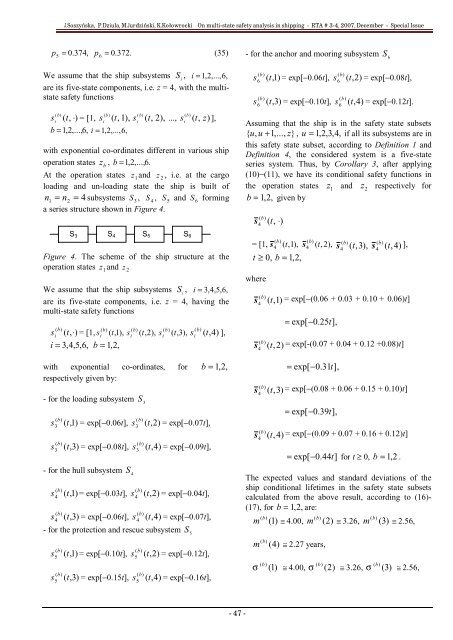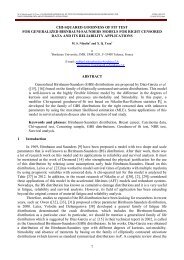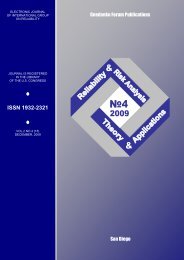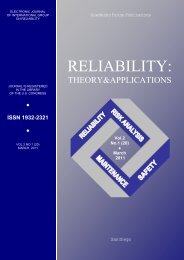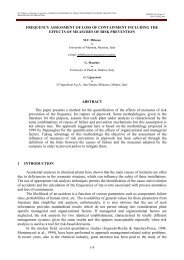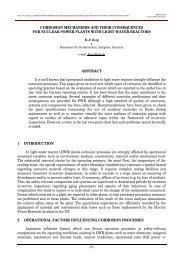J.Soszyska, P.Dziula, M.Jurdziski, K.KoowrockiOn multi-state safety analysis <strong>in</strong> shipp<strong>in</strong>g - RTA # 3-4, 2007, December - Special Issuestates: z1, z2, z3, z4, z5, z 6 . On the basis of datacom<strong>in</strong>g from experts, the probabilities of transitionsbetween the operation states are approximately givenbyWhereas, by (27), the unconditional mean lifetimes <strong>in</strong>the operation states areM 1= E[ θ 1] = p13M13+ p15M15+ p16M16[ ] 6 6p blx⎡0.00⎢⎢0.48⎢0.00= ⎢⎢0.49⎢0.02⎢⎢⎣0.020.000.000.000.490.020.020.960.480.000.020.000.000.000.000.020.000.480.010.020.020.960.000.000.950.02⎤0.02⎥⎥0.02⎥⎥,0.00⎥0.48⎥⎥0.00⎥⎦= 0 .96 ⋅ 2 + 0.02 ⋅1+ 0.02 ⋅1= 1.96,M 2= E[ θ 2]= p + + +21M21p23M23p25M25p26M26= 0 .48 ⋅ 2 + 0.48 ⋅ 2 + 0.02 ⋅1+ 0.02 ⋅1=1.96,and the distributions of the ship conditional lifetimes <strong>in</strong>the operation states are exponential of the follow<strong>in</strong>gforms:HHHHHHHHH( t)= 1 − exp[ −0.5], H ( t)= 1 − exp[ −1.0],13t15t( t)= 1 − exp[ −1.0], H ( t)= 1 − exp[ −0.5],16t21t( t)= 1 − exp[ −0.5], H ( t)= 1 − exp[ −1.0],23t25t( t)= 1 − exp[ −1.0], H ( t)= 1 − exp[ −25.0],26t34t( t)= 1 − exp[ −25.0], H ( t)= 1 − exp[ −12.5],35t36t( t)= 1 − exp[ −0.33], H ( t)= 1 − exp[ −0.33],51t52t( t)= 1 − exp[ −0.5], H ( t)= 1 − exp[ −0.5],54tfor t ≥ 0.56t( t)= 1 − exp[ −0.2], H ( t)= 1 − exp[ −0.2],61t62t( t)= 1 − exp[ −0.25], H ( t)= 1 − exp[ −0.25]64t65tHence, by (26), the conditional mean values oflifetimes <strong>in</strong> the operation states areM 13 = 2, M , M 16 = 1,15 =1M 21 = 2, M 23 = 2,M 25 =1,M 26 = 1,M 34 = 0.04, M 35 = 0.04,M 36 = 0.08,M 41 = 0.08, M 42 = 0.08,M 43 = 0.04,M 51 = 3, M 52 = 3,M 54 = 2,M 56 = 2,M 61 = 5, M 62 = 5,M 64 = 4,M 65 = 4.M 3= E[ θ 3] = p34M34+ p35M35+ p36M36= 0 .02 ⋅ 0.04 + 0.96 ⋅ 0.04 + 0.02 ⋅ 0.08 = 0.0408,M 4= E[ θ 4] = p41M41+ p42M42+ p43M43= 0 .49 ⋅ 0.08 + 0.49 ⋅ 0.08 + 0.02 ⋅ 0.04 = 0.0792,M 5= E[ θ 5]= p + + +51M51p52M52p54M54p56M56= 0 .02 ⋅ 3 + 0.02 ⋅ 3 + 0.48 ⋅ 2 + 0.48 ⋅ 2 = 2.04,M 6= E[ θ 6]= p + + +61M61p62M62p64M64p65M65= 0 .02 ⋅ 5 + 0.02 ⋅ 5 + 0.01⋅4 + 0.95 ⋅ 4 = 4.04.S<strong>in</strong>ce from the system of equations⎧[π 1,π 2 , π 3,π 4 , π 5 , π 6 ]⎪⎨=[ π 1,π 2 , π 3,π 4 , π 5,π 6 ]⎪⎩π1+ π2+ π3+ π4+ π5+ πwe get[ ]p bl 6x66= 1,π 1 = 0.126, π 2 = 0.085,π 3 = 0.165,π 4 = 0.155, π 5 = 0.312,π 6 = 0.157,then the limit values of the transient probabilitiesp b(t) at the operational states zb, accord<strong>in</strong>g to (28),are given byp 1 = 0.145, p 2 = 0.098,p 3 = 0.004,p 4 = 0.007,- 46 -
J.Soszyska, P.Dziula, M.Jurdziski, K.KoowrockiOn multi-state safety analysis <strong>in</strong> shipp<strong>in</strong>g - RTA # 3-4, 2007, December - Special Issuep 5 = 0.374, p 6 = 0.372.(35)We assume that the ship subsystems S ,ii = 1,2,...,6,are its five-state components, i.e. z = 4, with the multistatesafety functions( )s b( )( t,⋅)= [1, s b( )( t,1),s b( )( t,2),..., s b( t,z)],i i i ib =1,2,...,6, i = 1,2,...,6,with exponential co-ord<strong>in</strong>ates different <strong>in</strong> various shipoperation states z , b =1,2,...,6.bAt the operation states z1and z 2 , i.e. at the cargoload<strong>in</strong>g and un-load<strong>in</strong>g state the ship is built ofn1 = n2= 4 subsystems S3,S4, S5and S6form<strong>in</strong>ga series structure shown <strong>in</strong> Figure 4.Figure 4. The scheme of the ship structure at theoperation states z1and z 2We assume that the ship subsystems S ,ii = 3,4,5,6,are its five-state components, i.e. z = 4, hav<strong>in</strong>g themulti-state safety functions( )s b( )i( t,⋅)= [1, s b ( )i( t,1),s b( )i( t,2),s b ( t,3),i = 3,4,5,6, b = 1,2,( )is b ( t,4)i],with exponential co-ord<strong>in</strong>ates, for b = 1,2,respectively given by:- for the load<strong>in</strong>g subsystem S 3( )s b ( )( ,1) = exp[−0.06t], s b ( ,2)= exp[−0.07t],3t3t( )s b ( )( ,3) = exp[−0.08t], s b ( ,4)= exp[−0.09t],3t- for the hull subsystem S 43t( )s b ( )( ,1) = exp[−0.03t], s b ( ,2)= exp[−0.04t],4t4t( )s b ( )4( t,3)= exp[−0.06t], s b4( t,4)= exp[−0.07t],- for the protection and rescue subsystem S 5( )s b ( )( ,1) = exp[−0.10t], s b ( ,2)= exp[−0.12t],5t5t( )s b ( )( ,3) = exp[−0.15t], s b ( ,4)= exp[−0.16t],5tS 3 S 4 S 5 S 65t- for the anchor and moor<strong>in</strong>g subsystem S 6( )s b ( )( ,1) = exp[−0.06t], s b ( ,2)= exp[−0.08t],6t6t( )s b ( )( ,3) = exp[−0.10t], s b ( ,4)= exp[−0.12t].6t6tAssum<strong>in</strong>g that the ship is <strong>in</strong> the safety state subsets{ u , u + 1,..., z}, u = 1,2,3,4 , if all its subsystems are <strong>in</strong>this safety state subset, accord<strong>in</strong>g to Def<strong>in</strong>ition 1 andDef<strong>in</strong>ition 4, the considered system is a five-stateseries system. Thus, by Corollary 3, after apply<strong>in</strong>g(10)−(11), we have its conditional safety functions <strong>in</strong>the operation states z1and z2respectively forb = 1,2, given by( b)s4 ( t,⋅)( b)( b)= [1, s4( t,1),s4( t,2),( b)( b)s4( t,3),s4( t,4)],t ≥ 0, b = 1,2,wheressss( b)4t( b)4t( ,1) = exp[−(0.06 + 0.03 + 0.10 + 0.06)t]= exp[ −0.25t],( ,2) = exp[-(0.07 + 0.04 + 0.12 +0.08)t]( b)4t( b)4t= exp[ −0.31t],( ,3) = exp[−(0.08 + 0.06 + 0.15 + 0.10)t]= exp[ −0.39t],( ,4) = exp[−(0.09 + 0.07 + 0.16 + 0.12)t]= exp[ −0.44t]for t ≥ 0, b = 1, 2 .The expected values and standard deviations of theship conditional lifetimes <strong>in</strong> the safety state subsetscalculated from the above result, accord<strong>in</strong>g to (16)-(17), for b = 1,2,are:(b)(b)m (1) ≅ 4.00, (2)(b)m (4)≅ 2.27 years,(b)(b)σ (1) ≅ 4.00, (2)(b)m ≅ 3.26, m (3)≅ 2.56,(b)σ ≅ 3.26, σ (3)≅ 2.56,- 47 -
- Page 1 and 2: ISSN 1932-2321RELIABILITY:Theory &
- Page 5 and 6: e‐journal “Reliability: Theory&
- Page 7: e‐journal “Reliability: Theory&
- Page 10 and 11: A.Blokus-Roszkowska Analysis of com
- Page 12: A.Blokus-Roszkowska Analysis of com
- Page 20 and 21: R. Bri Stochastic ageing models - e
- Page 22 and 23: R. Bri Stochastic ageing models - e
- Page 24 and 25: R. Bri Stochastic ageing models - e
- Page 26 and 27: R. Bri Stochastic ageing models - e
- Page 28 and 29: T.BudnyTwo various approaches to VT
- Page 30 and 31: T.BudnyTwo various approaches to VT
- Page 32 and 33: T.BudnyTwo various approaches to VT
- Page 34 and 35: J.Duarte, C.Soares Optimisation of
- Page 36 and 37: J.Duarte, C.Soares Optimisation of
- Page 38 and 39: J.Duarte, C.Soares Optimisation of
- Page 40 and 41: J.Soszyska, P.Dziula, M.Jurdziski,
- Page 42 and 43: J.Soszyska, P.Dziula, M.Jurdziski,
- Page 44 and 45: J.Soszyska, P.Dziula, M.Jurdziski,
- Page 48 and 49: J.Soszyska, P.Dziula, M.Jurdziski,
- Page 50 and 51: J.Soszyska, P.Dziula, M.Jurdziski,
- Page 52 and 53: J.Soszyska, P.Dziula, M.Jurdziski,
- Page 54 and 55: M.Elleuch, B.Ben, F.MasmoudiImprove
- Page 56 and 57: M.Elleuch, B.Ben, F.MasmoudiImprove
- Page 58 and 59: M.Elleuch, B.Ben, F.MasmoudiImprove
- Page 60 and 61: F.GrabskiApplications of semi-Marko
- Page 62 and 63: F.GrabskiApplications of semi-Marko
- Page 64 and 65: F.GrabskiApplications of semi-Marko
- Page 66 and 67: F.GrabskiApplications of semi-Marko
- Page 68 and 69: F.GrabskiApplications of semi-Marko
- Page 70 and 71: F.GrabskiApplications of semi-Marko
- Page 72 and 73: F.GrabskiApplications of semi-Marko
- Page 74 and 75: F.GrabskiApplications of semi-Marko
- Page 76 and 77: F.Grabski The random failure rate -
- Page 78 and 79: F.Grabski The random failure rate -
- Page 80 and 81: F.Grabski The random failure rate -
- Page 82 and 83: F.Grabski The random failure rate -
- Page 84 and 85: F.Grabski, A. Zaska-FornalThe model
- Page 86 and 87: F.Grabski, A. Zaska-FornalThe model
- Page 88 and 89: F.Grabski, A. Zaska-FornalThe model
- Page 90 and 91: R.GuoAn univariate DEMR modelling o
- Page 92 and 93: R.GuoAn univariate DEMR modelling o
- Page 94 and 95: R.GuoAn univariate DEMR modelling o
- Page 96 and 97:
R.GuoAn univariate DEMR modelling o
- Page 98 and 99:
S.Guze Numerical approach to reliab
- Page 100 and 101:
S.Guze Numerical approach to reliab
- Page 102 and 103:
S.Guze Numerical approach to reliab
- Page 104 and 105:
S.Guze, K.Koowrocki Reliability ana
- Page 106 and 107:
S.Guze, K.Koowrocki Reliability ana
- Page 108 and 109:
S.Guze, K.Koowrocki Reliability ana
- Page 110 and 111:
S.Guze, K.Koowrocki Reliability ana
- Page 112 and 113:
L.Knopik Some remarks on mean time
- Page 114 and 115:
L.Knopik Some remarks on mean time
- Page 116 and 117:
K.Koowrocki Reliability modelling o
- Page 118 and 119:
K.Koowrocki Reliability modelling o
- Page 120 and 121:
K.Koowrocki Reliability modelling o
- Page 122 and 123:
K.Koowrocki Reliability modelling o
- Page 124 and 125:
K.Koowrocki Reliability modelling o
- Page 126 and 127:
K.Koowrocki Reliability modelling o
- Page 128 and 129:
K.Koowrocki Reliability modelling o
- Page 130 and 131:
K.Koowrocki Reliability modelling o
- Page 132 and 133:
K.Koowrocki Reliability modelling o
- Page 134 and 135:
K.Koowrocki Reliability modelling o
- Page 136 and 137:
K.Koowrocki Reliability modelling o
- Page 138 and 139:
K.Koowrocki Reliability modelling o
- Page 140 and 141:
A. Kudzys Transformed conditional p
- Page 142 and 143:
A. Kudzys Transformed conditional p
- Page 144 and 145:
A. Kudzys Transformed conditional p
- Page 146 and 147:
A. Kudzys Transformed conditional p
- Page 148 and 149:
B. Kwiatuszewska-Sarnecka On asympt
- Page 150 and 151:
B. Kwiatuszewska-Sarnecka On asympt
- Page 152 and 153:
B. Kwiatuszewska-Sarnecka On asympt
- Page 154 and 155:
B. Kwiatuszewska-Sarnecka On asympt
- Page 156 and 157:
B. Kwiatuszewska-Sarnecka On asympt
- Page 158 and 159:
B. Kwiatuszewska-Sarnecka On asympt
- Page 160 and 161:
B. Kwiatuszewska-Sarnecka On asympt
- Page 162 and 163:
B. Kwiatuszewska-Sarnecka On asympt
- Page 164 and 165:
B. Kwiatuszewska-Sarnecka On asympt
- Page 166 and 167:
B. Kwiatuszewska-Sarnecka On asympt
- Page 168 and 169:
B. Kwiatuszewska-Sarnecka On asympt
- Page 170 and 171:
B. Kwiatuszewska-Sarnecka On asympt
- Page 172 and 173:
U. Rakowsky Fundamentals of the Dem
- Page 174 and 175:
U. Rakowsky Fundamentals of the Dem
- Page 176 and 177:
U. Rakowsky Fundamentals of the Dem
- Page 178 and 179:
U. Rakowsky Fundamentals of the Dem
- Page 180 and 181:
U. Rakowsky Fundamentals of the Dem
- Page 182 and 183:
U. Rakowsky Fundamentals of the Dem
- Page 184 and 185:
J. Soszyska Systems reliability ana
- Page 186 and 187:
J. Soszyska Systems reliability ana
- Page 188 and 189:
J. Soszyska Systems reliability ana
- Page 190 and 191:
J. Soszyska Systems reliability ana
- Page 192 and 193:
J. Soszyska Systems reliability ana
- Page 194 and 195:
J. Soszyska Systems reliability ana
- Page 196 and 197:
D. Vali Reliability of complex syst
- Page 198 and 199:
D. Vali Reliability of complex syst
- Page 200 and 201:
D. Vali Reliability of complex syst
- Page 202 and 203:
D. Vali Reliability of complex syst
- Page 204 and 205:
E. Zio Soft computing methods appli
- Page 206 and 207:
E. Zio Soft computing methods appli
- Page 208 and 209:
E. Zio Soft computing methods appli
- Page 210 and 211:
E. Zio Soft computing methods appli
- Page 212 and 213:
E. Zio Soft computing methods appli
- Page 214 and 215:
E. Zio Soft computing methods appli
- Page 216 and 217:
E. Zio Soft computing methods appli
- Page 218 and 219:
E. Zio Soft computing methods appli
- Page 220 and 221:
E.Zio, P.Baraldi, I.Popescu Optimiz
- Page 222 and 223:
E.Zio, P.Baraldi, I.Popescu Optimiz
- Page 224 and 225:
E.Zio, P.Baraldi, I.Popescu Optimiz
- Page 226 and 227:
E.Zio, P.Baraldi, I.Popescu Optimiz
- Page 228 and 229:
E.Zio, P.Baraldi, I.Popescu Optimiz
- Page 230 and 231:
NOTES


